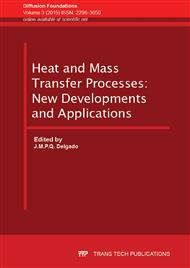[1]
E. Barreira, J.M.P.Q. Delgado and V.P. de Freitas: Wetting and Drying of Building Materials, Drying and Wetting of Building Materials and Components, Chap. 3, 51–69, edited by J.M.P.Q. Delgado, Book Series: Building Pathology and Rehabilitation - Vol. 4, Springer, ISBN: 978-3-319-04531-3 (2014).
DOI: 10.1007/978-3-319-04531-3_3
Google Scholar
[2]
T. Bednar: Approximation of Liquid Moisture Transport Coefficient of Porous Building Materials by Suction and Drying Experiments. Demands on Determination of Drying Curve (Proceedings of the 6th Symposium on Building Physics in the Nordic Countries. Trondheim. Norway. p.493.
Google Scholar
[3]
J. Crank: The mathematics of diffusion (Oxford Science. New York. 1975).
Google Scholar
[4]
J.M.P.Q. Delgado. N.M.M. Ramos and V.P. de Freitas: Can moisture buffer performance be estimated from sorption kinetics? J. Building Physics, Vol. 29 (4): 281-299 (2006).
DOI: 10.1177/1744259106062568
Google Scholar
[5]
L. Derdour. H. Desmorieux and J. Andrieu: A contribution to the characteristic drying curve concept: Application to the drying of plaster. Drying Technology, Vol. 18 (1): 237-260 (2000).
DOI: 10.1080/07373930008917702
Google Scholar
[6]
V.P. de Freitas: Moisture Transfer in Building Walls, PhD Thesis, Faculdade de Engenharia da Universidade do Porto, Portugal, 1992 (in Portuguese).
Google Scholar
[7]
V.P. de Freitas, V. Abrantes and P. Crausse: Moisture migration in building walls – Analysis of the interface phenomena. Building and Environment, Vol. 31(2): 99-108 (1996).
DOI: 10.1016/0360-1323(95)00027-5
Google Scholar
[8]
C.L. Hii, C. L Law and M. Cloke: Modeling using a new thin layer drying model and product quality of cocoa. Journal of Food Engineering, Vol. 90: 191–198 (2009).
DOI: 10.1016/j.jfoodeng.2008.06.022
Google Scholar
[9]
M. Karoglou, A. Moropoulou, Z.B. Maroulisa and M.K. Krokida: Drying Kinetics of Some Building Materials. Drying Technology, Vol. 23 (1-2): 305-315 (2005).
DOI: 10.1081/drt-200047926
Google Scholar
[10]
M. Krus and A. Holm: Simple Methods to Approximate the Liquid Transport Coefficients Describing the Absorption and Drying Process (Proceedings of the 5th Symposium on Building Physics in the Nordic Countries. Goteborg. Norway. p.241. 1999).
Google Scholar
[11]
M. Planinic´, D. Velic´, S. Tomas, M. Bilic´ and A. Bucic: Modelling of drying and rehydration of carrots using Peleg�s model. European Food Research Technology, Vol. 221: 445-451 (2005).
DOI: 10.1007/s00217-005-1200-x
Google Scholar
[12]
Z.B. Maroulis and G.D. Saravacos: Food Process Design (Marcel Dekker, New York, USA. 2003).
Google Scholar
[13]
H. Midilli, H. Kucuk and Z. Yapar: A New Model for Single-Layer Drying. Drying Technology, Vol. 20(7): 1503-1513(2002).
DOI: 10.1081/drt-120005864
Google Scholar
[14]
M. Peleg: An empirical model for the description of moisture sorption curves. Journal of Food Science, Vol. 53: 1216–1219 (1988).
DOI: 10.1111/j.1365-2621.1988.tb13565.x
Google Scholar
[15]
I.T. Toğrul and D. Pehlivan: Modelling of drying kinetics of single apricot. Journal of Food Engineering, Vol. 58 (1): 23-32 (2003).
DOI: 10.1016/s0260-8774(02)00329-1
Google Scholar
[16]
T.L. Thompson, R.M. Peart and G.H. Foster: Mathematical Simulation of Corn DryingA New Model. Transactions of the ASAE, 11, 582-586 (1968).
Google Scholar
[17]
M. Turhan, S. Sayar and S. Gunasekaran: Application of Peleg model to study water absorption in chickpea during soaking. Journal of Food Engineering, Vol. 53: 153-159 (2002).
DOI: 10.1016/s0260-8774(01)00152-2
Google Scholar
[18]
A. Yagcıoglu, A. Degirmencioglu and F. Cagatay: Drying Characteristic of Laurel Leaves under Different Conditions (Proceedings of the 7th International Congress on Agricultural Mechanization and Energy. May 26-27. Adana. Turkey. 1999).
Google Scholar
[19]
C.Y. Wang and R.P. Singh: Single Layer Drying Equation for RoughRice. ASAE Press, St. Joseph, MI, USA, (1978).
Google Scholar
[20]
WUFI: WUFI Pro 5. 3 Fraunhofer – IBP, Holzkirchen, Germany (2014).
Google Scholar


